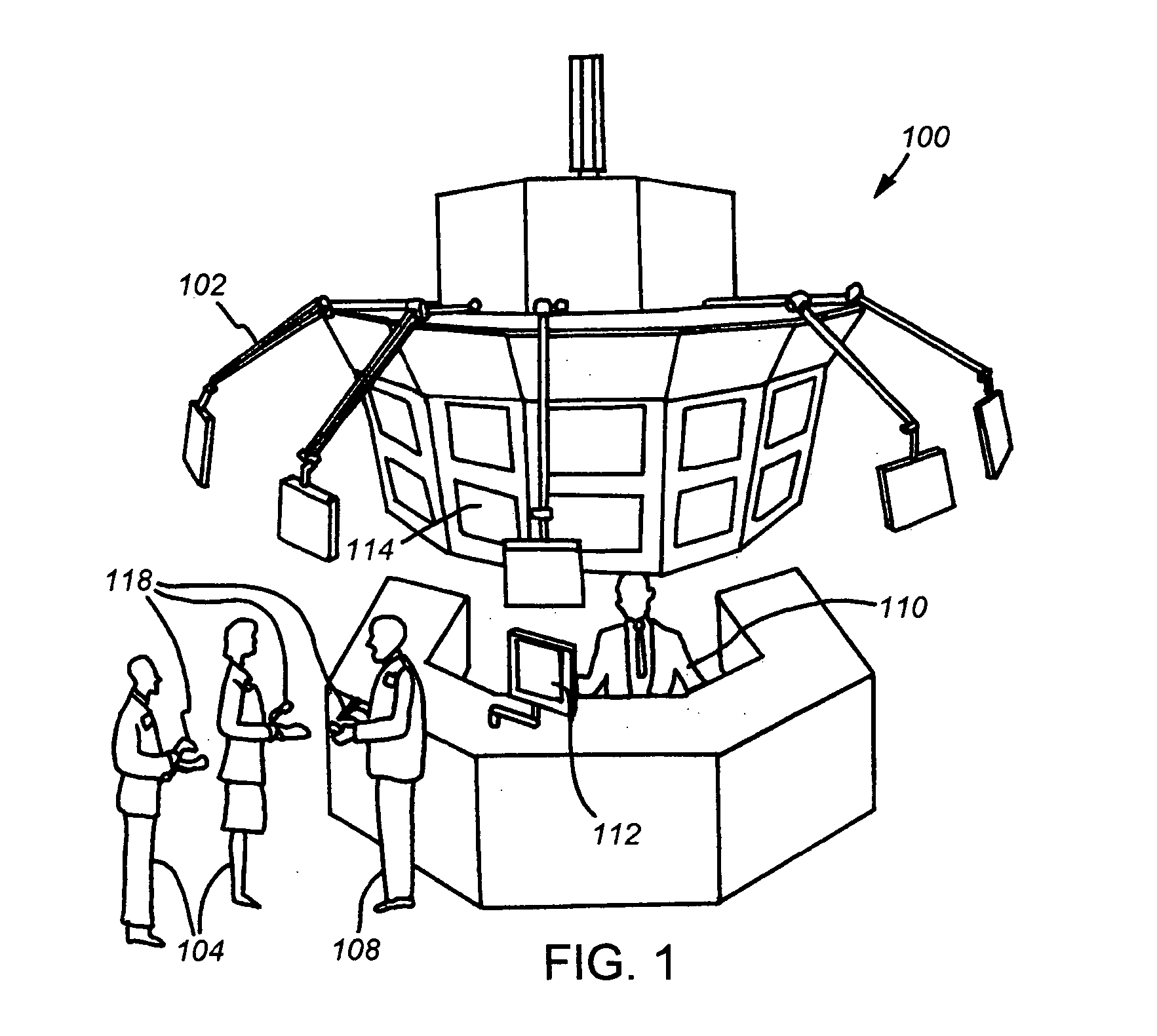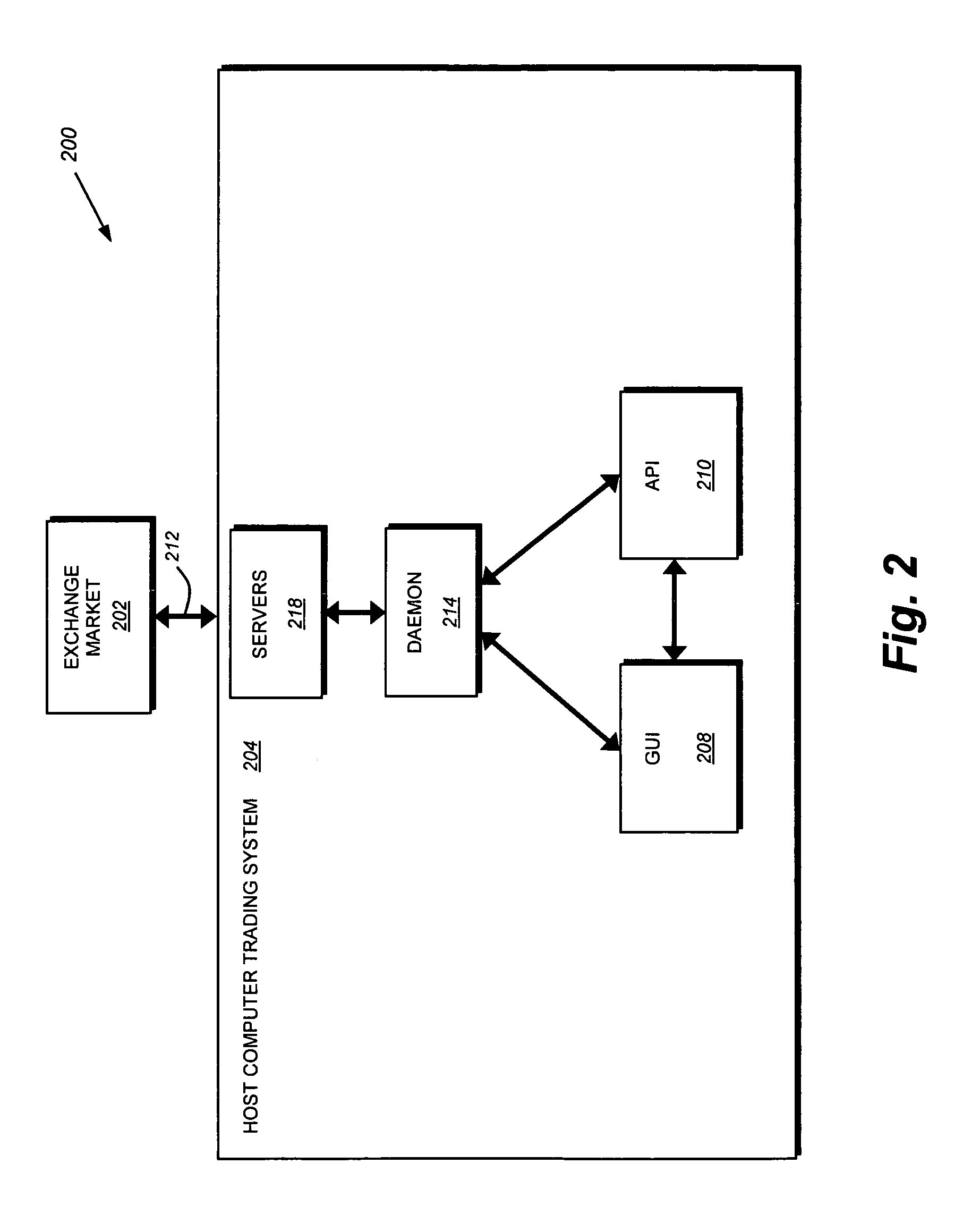[0090] Referring to FIG. 13, the API 210 may be seamlessly integrated with the GUI 208, so that the trader sees what the API 210 is doing at any given time when looking at the GUI 208, and the API 210 sees events created by the trader when the trader interacts with the GUI 208. A virtual book in the GUI 208 transmits information to the API 210. Instead of requiring the trader to keep track of orders, it allows the trader to keep track of “perfect world” positions. The API 210 then determines the difference between the “perfect world” positions in the virtual book and the trader's actual positions. The API 210 then hands instructions to the
daemon 214 to cause it to execute transactions that eliminate the difference between the desired position and the actual position. Thus, the trader can think in conventional trading terms, such as “I want to be long 50.” The API 210 and
daemon 214 cancel orders, place orders, and the like to get the trader to the position of being long 50, regardless of what the trader's earlier position was. The trader does not have to know anything about the specific orders that have been placed or even think about specific orders. The trader just indicates the degree of
exposure, price, quantity, and symbol in the GUI 208 and the API 210 and
daemon 214 of the host computer trading
system 204 determine the current state, interpret the differential between the current state and the desired state, and place and / or cancel orders to arrive at the desired state. Unlike conventional APIs, which usually require a trader or an employee to work in complex exchange messaging protocols s, the API 210 is a simple interface that allows a trader to specify common trading rules, such as limit orders, stop loss orders and the like. The trader deals in comfortable terms such as “long,”“short,”“quantity” and“price,” rather than having to work with specific orders, tickets or the like. The API 210 and daemon 214 deals with turning the current position into the trader's ideal position by automatically buying, selling, canceling and managing orders. For example, if the trader has ten orders in and wants to be long 20, then the host computer trading
system 204 could read an input of “long 20” in the GUI 208 and automatically add ten more orders to get the trader to the long 20 position. An
advantage of the invention is that the trader is not required to submit orders or to provide the exchange with a
ticket number. Management of
ticket numbers with a market exchange 202 can be quite complex, and the methods and systems described herein allow the trader to completely sidestep the process, freeing up valuable time to focus on market information.
[0091] In FIG. 14, a high level
flow chart of an embodiment of a trade method is shown. A price bar 1400 may be provided for the user to view the prices of a particular commodity. The price bar 1400 may be divided into ask prices and bid prices; the bid and ask prices may be indicated by different colors in the interface. The price bar may be dynamic in the display of the current commodity prices by adjusting the display of the prices to maintain an equal number of displayed ask and bid prices. The ask and bid prices may continually change, based on the market value of the commodity as it is traded on an exchange. For example, the price bar may be adjusted so as to continually center the current market price on the display.
[0092] As the user is viewing the trading interface, the user may decide to make a bid or ask trade. In an embodiment, the user may select 1402 a price to make a bid or ask using an
input device such as a mouse or keyboard. The user may need to make rapid bid / ask decisions as to which displayed price will be selected 1402 as the trade price. The price bar may be changing as the commodity price, book, and order market information is updated. In an embodiment, the user may be able to start the bid / ask process by providing a down click and hold of a mouse. This action may allow the user to move the bid / ask indicator over the entire displayed commodity price bar to make the price selection 1402. In this way, the user may be able to select 1402 the prices based on all of the inputs provided by the interface.
[0093] In an embodiment, once the user is satisfied that the buy / sell indicator is selecting 1402 the desired price, the user may up click the mouse to set the order 1404 for the bid / ask. This action may allow for very rapid decisions by the user, based on the market information displayed on the interface. The up click action may start the order 1404 process and may
display order 1404 information such as the number of commodities bought / sold, a revised book price, and the status of the trade. Executing the order 1404 may send information to the API order creation 1408 to apply the rules of the API 1408 to the executed order. Based on the user rules in the API 1408, an order may be placed 1410 to the appropriate exchange and the
order status may be updated on the trade interface.
[0094] In FIG. 15, the trade interface for selecting a bid is shown. The price bar 1500 may display the current bid and ask market prices. The price bar 1500 may be dynamic; it may maintain a display of an equal number of bid and ask prices on the interface. In an embodiment, the ask 1502 prices may be displayed as one color at the top of the price bar 1502 and the bid 1504 prices may be in a second color at the bottom of the price bar 1502. The price bar 1502 may be further divided by highlighting the ask book price 1508 and the bid book price 1512 in different color intensities. The interface may also maintain columns showing the book quantity 1514, order quantity 1518, trades 1520, net position 1522, and any computer generated orders 1524.
[0095] To select a bid / ask price to place a order, the user may indicate a bid / ask price on the price bar 1500 with an
input device such as a mouse or keyboard by positioning the bid / ask indicator over the desired price. An ask order may be selected by moving the indicator to the ask price 1502 side of the price bar 1500 and a bid may be selected by moving the indicator to the bid price 1504 side of the price bar 1500. Because the price bar 1500 may be dynamically updating market information, the
user needs a
selection method capable of implementing rapid decision-making. A two-step action from an
input device may be used to select and order a trade. In an embodiment, a user may use a mouse to select the desired price with a down click and hold action. This may allow the user to move the indicator over the price bar 1500 to indicate 1512 a bid price. An order may not be placed as long as the user continues to hold the
mouse button in the down position.
 Login to View More
Login to View More  Login to View More
Login to View More 


